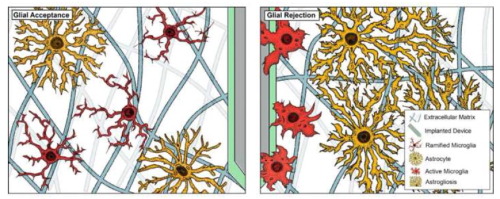当前位置:
X-MOL 学术
›
Acta Biomater.
›
论文详情
Our official English website, www.x-mol.net, welcomes your
feedback! (Note: you will need to create a separate account there.)
Biomaterials and glia: Progress on designs to modulate neuroinflammation.
Acta Biomaterialia ( IF 9.4 ) Pub Date : 2018-11-07 , DOI: 10.1016/j.actbio.2018.11.008 C Tsui 1 , K Koss 2 , M A Churchward 2 , K G Todd 3
Acta Biomaterialia ( IF 9.4 ) Pub Date : 2018-11-07 , DOI: 10.1016/j.actbio.2018.11.008 C Tsui 1 , K Koss 2 , M A Churchward 2 , K G Todd 3
Affiliation

|
Microglia are multi-functional cells that play a vital role in establishing and maintaining the function of the nervous system and determining the fate of neurons following injury or neuropathology. The roles of microglia are diverse and essential to the capacity of the nervous system to recover from injury, however sustained inflammation can limit recovery and drive chronic disease processes such as neurodegenerative disorders. When assessing implantable therapeutic devices in the central nervous system, an improved lifetime of the implant is considered achievable through the attenuation of microglial inflammation. Consequently, there is a tremendous underexplored potential in biomaterial and engineered design to modulate neuroinflammation for therapeutic benefit. Several strategies for improving device compatibility reviewed here include: biocompatible coatings, improved designs in finer and flexible shapes to reduce tissue shear-related scarring, and loading of anti-inflammatory drugs. Studies about microglial cell cultures in 3D hydrogels and nanoscaffolds to assess various injuries and disorders are also discussed. A variety of other microglia-targeting treatments are also reviewed, including nanoparticulate systems, cellular backpacks, and gold plinths, with the intention of delivering anti-inflammatory drugs by targeting the phagocytic nature of microglia. Overall, this review highlights recent advances in biomaterials targeting microglia and inflammatory function with the potential for improving implant rejection and biocompatibility studies. STATEMENT OF SIGNIFICANCE: Microglia are the resident immune cells of the central nervous system, and thus play a central role in the neuroinflammatory response against conditions than span acute injuries, neuropsychiatric disorders, and neurodegenerative disorders. This review article presents a summary of biomaterials research that target microglia and other glial cells in order to attenuate neuroinflammation, including but not limited to: design of mechanically compliant and biocompatible stimulation electrodes, hydrogels for high-throughput 3D modelling of nervous tissue, and uptake of nanoparticle drug delivery systems. The goal of this paper is to identify strengths and gaps in the relevant literature, and to promote further consideration of microglia behaviour and neuroinflammation in biomaterial design.
中文翻译:

生物材料和神经胶质:调节神经炎症设计的进展。
小胶质细胞是多功能细胞,在建立和维持神经系统功能以及确定损伤或神经病理学后神经元的命运方面起着至关重要的作用。小胶质细胞的作用是多种多样的,对于神经系统从损伤中恢复的能力至关重要,但是持续的炎症会限制其恢复并驱动慢性疾病过程,例如神经退行性疾病。当评估中枢神经系统中的可植入治疗设备时,可以认为通过减轻小胶质细胞炎症可以延长植入物的寿命。因此,在生物材料和工程设计方面存在巨大的未开发潜力,可以调节神经炎症以获得治疗益处。这里介绍了几种改善设备兼容性的策略,包括:生物相容性涂层,更精细,更灵活的形状的改进设计,以减少与组织剪切相关的疤痕,以及消炎药的装载量。还讨论了有关在3D水凝胶和纳米支架中评估小胶质细胞培养以评估各种损伤和疾病的研究。还综述了多种其他靶向小胶质细胞的治疗方法,包括纳米颗粒系统,细胞背包和金质底座,旨在通过靶向小胶质细胞的吞噬特性来递送抗炎药。总的来说,这篇综述着重介绍了针对小胶质细胞和炎症功能的生物材料的最新进展,有望改善植入物的排斥反应和生物相容性研究。意义声明:小胶质细胞是中枢神经系统的固有免疫细胞,因此,与急性损伤,神经精神疾病和神经退行性疾病相比,它在针对疾病的神经炎性反应中起着核心作用。这篇综述文章提供了针对小胶质细胞和其他神经胶质细胞以减轻神经炎症的生物材料研究的摘要,包括但不限于:机械适应性和生物相容性刺激电极的设计,用于神经组织高通量3D建模的水凝胶以及摄取纳米药物输送系统。本文的目的是确定相关文献中的长处和不足之处,并在生物材料设计中促进对小胶质细胞行为和神经炎症的进一步考虑。这篇综述文章提供了针对小胶质细胞和其他神经胶质细胞以减轻神经炎症的生物材料研究的摘要,包括但不限于:机械适应性和生物相容性刺激电极的设计,用于神经组织高通量3D建模的水凝胶以及摄取纳米药物输送系统。本文的目的是确定相关文献中的长处和不足之处,并在生物材料设计中促进对小胶质细胞行为和神经炎症的进一步考虑。这篇综述文章提供了针对小胶质细胞和其他神经胶质细胞以减轻神经炎症的生物材料研究的摘要,包括但不限于:机械适应性和生物相容性刺激电极的设计,用于神经组织高通量3D建模的水凝胶和摄取纳米药物输送系统。本文的目的是确定相关文献中的长处和不足之处,并在生物材料设计中促进对小胶质细胞行为和神经炎症的进一步考虑。水凝胶用于神经组织的高通量3D建模以及纳米颗粒药物递送系统的吸收。本文的目的是确定相关文献中的长处和不足之处,并在生物材料设计中促进对小胶质细胞行为和神经炎症的进一步考虑。水凝胶用于神经组织的高通量3D建模以及纳米颗粒药物递送系统的吸收。本文的目的是确定相关文献中的长处和不足之处,并在生物材料设计中促进对小胶质细胞行为和神经炎症的进一步考虑。
更新日期:2018-11-08
中文翻译:

生物材料和神经胶质:调节神经炎症设计的进展。
小胶质细胞是多功能细胞,在建立和维持神经系统功能以及确定损伤或神经病理学后神经元的命运方面起着至关重要的作用。小胶质细胞的作用是多种多样的,对于神经系统从损伤中恢复的能力至关重要,但是持续的炎症会限制其恢复并驱动慢性疾病过程,例如神经退行性疾病。当评估中枢神经系统中的可植入治疗设备时,可以认为通过减轻小胶质细胞炎症可以延长植入物的寿命。因此,在生物材料和工程设计方面存在巨大的未开发潜力,可以调节神经炎症以获得治疗益处。这里介绍了几种改善设备兼容性的策略,包括:生物相容性涂层,更精细,更灵活的形状的改进设计,以减少与组织剪切相关的疤痕,以及消炎药的装载量。还讨论了有关在3D水凝胶和纳米支架中评估小胶质细胞培养以评估各种损伤和疾病的研究。还综述了多种其他靶向小胶质细胞的治疗方法,包括纳米颗粒系统,细胞背包和金质底座,旨在通过靶向小胶质细胞的吞噬特性来递送抗炎药。总的来说,这篇综述着重介绍了针对小胶质细胞和炎症功能的生物材料的最新进展,有望改善植入物的排斥反应和生物相容性研究。意义声明:小胶质细胞是中枢神经系统的固有免疫细胞,因此,与急性损伤,神经精神疾病和神经退行性疾病相比,它在针对疾病的神经炎性反应中起着核心作用。这篇综述文章提供了针对小胶质细胞和其他神经胶质细胞以减轻神经炎症的生物材料研究的摘要,包括但不限于:机械适应性和生物相容性刺激电极的设计,用于神经组织高通量3D建模的水凝胶以及摄取纳米药物输送系统。本文的目的是确定相关文献中的长处和不足之处,并在生物材料设计中促进对小胶质细胞行为和神经炎症的进一步考虑。这篇综述文章提供了针对小胶质细胞和其他神经胶质细胞以减轻神经炎症的生物材料研究的摘要,包括但不限于:机械适应性和生物相容性刺激电极的设计,用于神经组织高通量3D建模的水凝胶以及摄取纳米药物输送系统。本文的目的是确定相关文献中的长处和不足之处,并在生物材料设计中促进对小胶质细胞行为和神经炎症的进一步考虑。这篇综述文章提供了针对小胶质细胞和其他神经胶质细胞以减轻神经炎症的生物材料研究的摘要,包括但不限于:机械适应性和生物相容性刺激电极的设计,用于神经组织高通量3D建模的水凝胶和摄取纳米药物输送系统。本文的目的是确定相关文献中的长处和不足之处,并在生物材料设计中促进对小胶质细胞行为和神经炎症的进一步考虑。水凝胶用于神经组织的高通量3D建模以及纳米颗粒药物递送系统的吸收。本文的目的是确定相关文献中的长处和不足之处,并在生物材料设计中促进对小胶质细胞行为和神经炎症的进一步考虑。水凝胶用于神经组织的高通量3D建模以及纳米颗粒药物递送系统的吸收。本文的目的是确定相关文献中的长处和不足之处,并在生物材料设计中促进对小胶质细胞行为和神经炎症的进一步考虑。











































 京公网安备 11010802027423号
京公网安备 11010802027423号